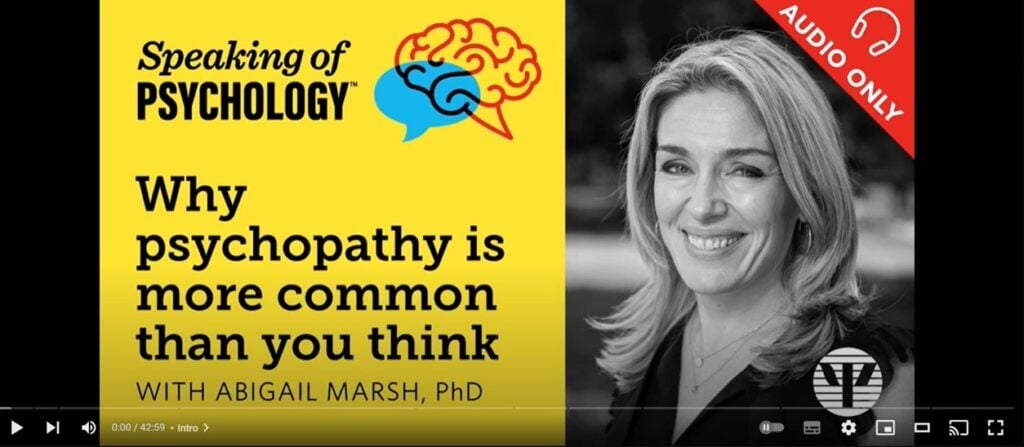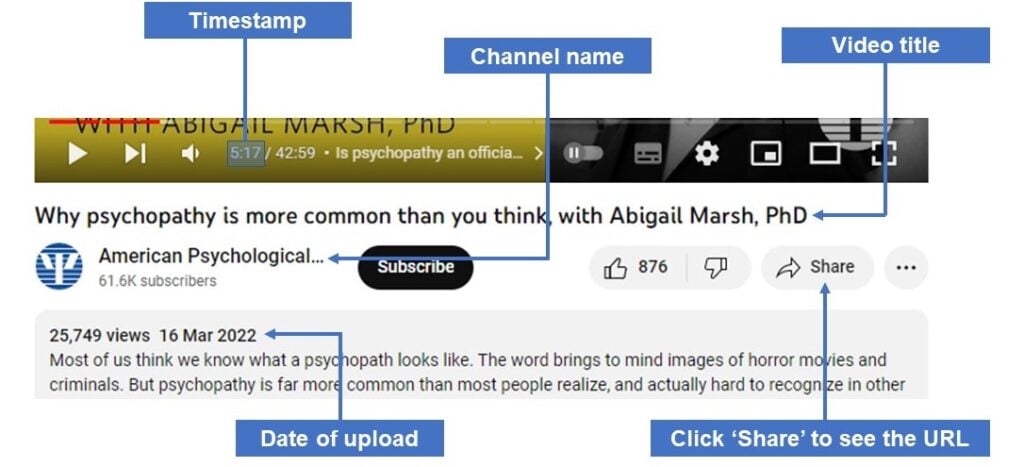On This Page:
To cite a YouTube video using the APA Referencing Style, you will need to find the person or organization that uploaded it, the channel name, date of upload, video title, website name (in this case, YouTube), and, lastly, the video link.
See below for our step-by-step guide using a real-life example.
Where To Find Citation Information
Firstly when writing your citation, you need to know where to find all the information needed.
You only need to look at three locations:
- For the video and YouTube channel name, look directly under the video
- For the upload date, look in the description bar of the video
- For the video link, look in the URL bar above the video
Step-by-step Guide
We will now guide you step-by-step on how to cite a YouTube video In APA style.
Let us assume that you would like to cite this video:

As mentioned, you will need the following information in this order:
- Channel name
- Date of upload
- Title of the video (italicized)
- The word “Video” in brackets
- Name of the site (in these cases, that would be “YouTube”)
- Video URL

Putting it all together in a formula, the structure of your reference should look like this:
Channel Name. (Year, Month (spelled out), Day (using numbers) of upload). Title of video [Video]. Title of website. Video URL

Taking our example, the finished reference would then be:
American Psychological Association. (2022, March 16th). Why psychopathy is more common than you think, with Abigail Marsh, PhD [Video]. YouTube. https://www.youtube.com/watch?v=bCgGfMZ3_t0
How To Write In-Text Citations
We will now look at how to write in-text citations for YouTube videos.
Similarly to how you would write an in-text citation for a research article or book chapter, you simply take the “author” name (in our case, this would be the “Channel name”), followed by a comma and the year of upload.
The formula structure looks like this:
Parenthetical citations: (Channel name, Year of upload)
Narrative citations: Channel name (Year of upload)
Based on our example, the in-text citation would then be:
Parenthetical citations: (American Psychological Association, 2022)
Narrative citations: American Psychological Association (2022)
What is important to remember is that for in-text citations in APA style, only the publication year is required, and we omit any other date information, such as day and month.
How To Include A Video Reference To The Reference Page
The last factor to consider when referencing a YouTube video is how to structure it in your “Reference Page.”
You will be happy to learn that your reference’s source format (e.g., article, video, blog post, etc.) has no effect on your reference page, and you can simply follow the same general APA rules set out.
Those would be:
- Adding your references in alphabetical order by the author’s last name (in our case, channel name)
- Ensuring that your list and references are double spaced
- Ensuring that every reference begins on a new line
- Adding a hanging indent for every new reference
How To Cite A YouTube Channel
Let us assume that instead of an individual video, you would like to reference an entire YouTube Channel. Using our example, this is how you would cite the “American Psychological Association” channel.
The formula structure should look like this:
Channel Name. (n.d.). Home [YouTube channel]. YouTube. Retrieved Month Date, Year, from URL of YouTube Channel
*n.d stands for no date.
** “Home” stands for the YouTube Home tab, where most channels are found by default. To cite other tabs, such as ” “Playlists,” follow the same formula structure and simply replace the tab placement with your chosen one. Kindly note that this is also italicized.
Based on our example, the reference would be:
American Psychological Association. (n.d.). Home [YouTube channel]. YouTube. Retrieved November 15, 2022 from https://www.youtube.com/@TheAPAVideo
Similarly, the in-text citation would be:
Parenthetical citations: (American Psychological Association, n.d.)
Narrative citations: American Psychological Association (n.d.)
*To find more citation information regarding the APA style, you can navigate to the official APA website: https://apastyle.apa.org/
Frequently asked questions
Should videos be used as references?
In academic writing, it is recommended that primary sources such as peer-reviewed papers, books, and book chapters should make up the majority of your references. This is to ensure the information you have included has been written and reviewed by field experts.
However, that being said, you can certainly cite secondary sources such as videos, online articles, and documentaries if they help provide important context and information to the point you are trying to make. Simply try to ensure that these are kept to a minimum where possible.
What types of videos are relevant to reference?
When referencing a video, it is important to ensure its relevance to demonstrate that you have critically considered and carefully selected your sources.
Videos that fall into this category can include but are not limited to: documentaries, biographies, docu-series, videos from channels of official bodies, e.g., the APA channel, video essays, critical perspectives, etc. Carefully consider the source’s credibility and how the video’s points assist your writing’s narrative or argumentation.
How is a direct quote from a video referenced?
If you would like to reference a direct quote from a video, then simply follow our YouTube video citation formula with the addition of a timestamp of when the quote begins next to the date.
Kindly note that time stamps are only needed for your in-text citations. You can omit them from the reference placed in your reference list.
Using our example, the in-text citation would look like this:
Parenthetical citations: (American Psychological Association, 2022, 2:44)
Narrative citations: American Psychological Association (2022, 2:44)
If you would like to cite multiple quotes from the same video, you can include timestamp ranges in your in-text citation separated by an en dash (-).
For example:
Parenthetical citations: (American Psychological Association, 2022, 2:44:3:16-17:45:19:00)
Narrative citations: American Psychological Association (2022, 2:44:3:16-17:45:19:00)
What Is APA Format?
The American Psychological Association (APA) formatting is a writing and referencing style dating back to 1929.
Developed by psychologists and other scholars, they set to standardize scientific writing by establishing a set of guidelines to be unanimously used across the discipline.
Thus, the APA style was born and has been adopted ever since by many fields, such as the behavioral and social sciences (Almeida, 2012).
This formatting style promotes concise, consistent, and persuasive writing. Special emphasis is given to the author’s ethical compliance and a reduction of prejudiced and biased descriptive language.
Frequent revisions are conducted to update the style, with the most current one (accessed when this article was published) being the 7th edition (American Psychological Association, 2020). Hence, the guidance provided in this article is based on the 7th edition APA manual.
References
Almeida, P. (2012, July 10). THE ORIGINS OF APA STYLE (AND WHY THERE ARE SO MANY RULES). Journal of European Psychology Students. https://blog.efpsa.org/2012/07/10/the-origins-of-apa-style-and-why-there-are-so-many-rules/
American Psychological Association. (2020). Publication manual of the American Psychological Association (7th ed.). https://doi.org/10.1037/0000165-000


